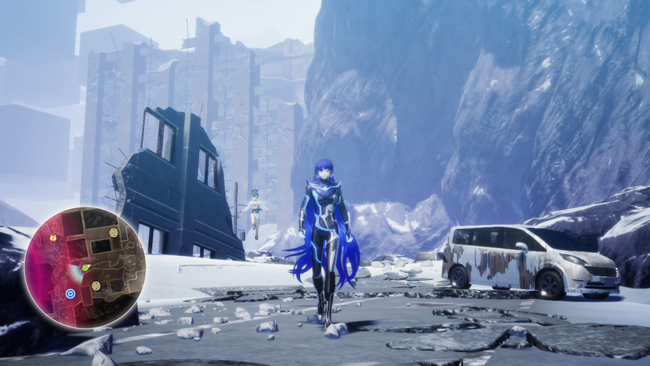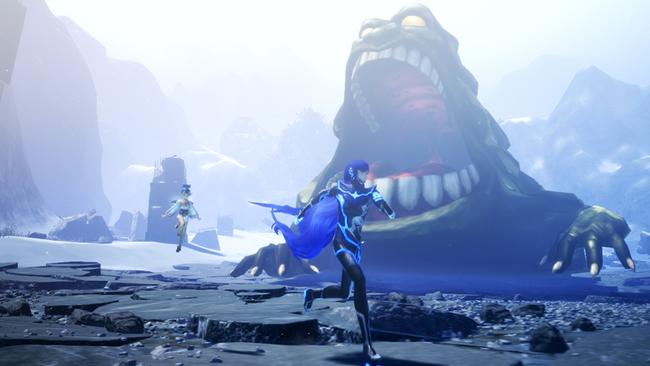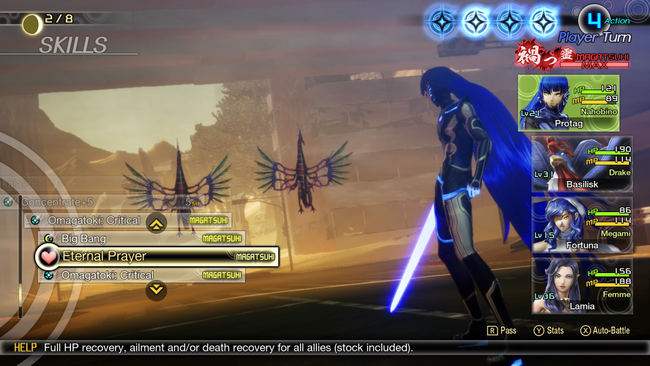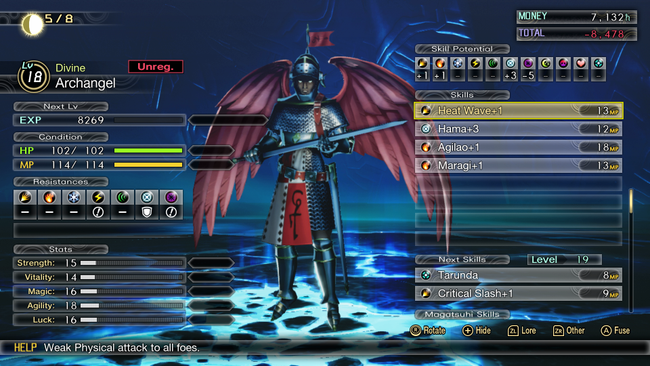Shin Megami Tensei V Review
Atlus has never before made a game quite like Shin Megami Tensei V.
I'm not trying to be colorful or poetic; I mean that as literally as possible. Atlus has never before functionally made a game with the same sort of design that SMT V exhibits. I'm not talking about the broader concepts of gods versus demons, order versus chaos, the mixed occultism & science fiction, or anything like that. All of those components are certainly still present, in some form, in Shin Megami Tensei's fifth main entry. But needless to say, the franchise has changed quite a bit from its dungeon-crawling origins.
In the lead up to the series's first simultaneous worldwide launch, we at RPG Site have seen a lot of excitement for Shin Megami Tensei V. It's only natural of course - it's been at least ten years since the last home console-bound entry in the franchise (the specifics are perhaps up to debate depending if you consider spinoffs like Devil Summoner or Digital Devil Saga as proper SMT games or not). In that excitement though, I've also seen a lot of concern and curiosity in wondering what exactly SMT V *is*, both from those very familiar with the series and those hoping to jump in for the first time.
For that reason, I think it is especially useful if I spend some words precisely describing what Shin Megami Tensei V is, as well as what it is not.

What makes SMT V different from nearly any Atlus game that has come before it is expressly its overall structure, which I'm going to spend a good percentage of this review discussing because it is easily the component most unique to SMT 5 when compared to its franchise counterparts. While the dungeon crawling elements that birthed the series have slowly been tapering away, their influence was noticeably still present in Shin Megami Tensei III: Nocturne and to a lesser extent Shin Megami Tensei IV. These often involved finding your way through labyrinthian mazes or precarious puzzles and the like. The trend away from the crawl is maintained here, as SMT V continues to move in the opposite direction.
For the most part, Shin Megami Tensei V is an open-world game. Well, not quite; let's say semi-open world.
I'm not quite talking about a huge map encompassing the entirety of the game world, like some sort of modern Ubisoft title. But unlike anything Atlus has made before, SMT or otherwise, you'll be spending the vast majority of your playtime running around an extensive post-apocalyptic Tokyo in real-time. There's no classic world map (for the most part), and separated locations are rare.
After the first 30 minutes or so of introductory scenes when booting up SMT V, the player-named protagonist is soon dropped into a ruined Tokyo known as Da'at, becomes the long-locked bluish Nahobino, and you'll begin spending hours upon hours exploring up & down sand dunes, around ruined buildings & bridges, discovering new items, completing quests, battling demons, and more. The only classically styled 'world map' you'll see is a small one in the early sections of the game, and you won't spend much time there at all. (This world map does have you navigate with the usual board game piece-like icon, which is pretty cool.)
SMT V's world sort of feels like what Nocturne's world would be like if it was made in the modern-day, turning the apocalypse into something you can actually explore, rather than only imagine from an abstracted world map. SMT V's world is largely split up into four primary zones, and each is quite sizable. Besides loading into each of these zones from a menu, the zones themselves are absent from any sort of loading screen. If you are the type of person to be thorough in your playthroughs and explore every cranny, complete every quest, and find every secret for yourself, you might spend roughly 8-10 hours in each of these areas. Of course, you can always mainline straight to the primary objectives and skip out on the optional exploration & quests, but I hope I'm highlighting just what you can expect to find in SMT V. It's not quite fully open-world, but it has several of those sorts of trappings in its open zone design.

It's genuinely awesome to see well-known SMT creatures roaming around the apocalyptic Tokyo landscapes. Whether it's Bicorns galloping around the sand dunes, Nagas slithering around abandoned shipping containers, a menacing Jatayu circling around his nest in Kamiyacho, or the huge golden Chinese dragon Huang Long floating way up in the sky, it is legitimately cool to see these creatures truly acting as part of their environments for the first time in the series.
Music throughout each zone is comfortably atmospheric in nature, but each area theme suits their respective zone notably well. Of course, the game also has a surprising variety of high-energy battle tracks that kick in in just the right way for the game's numerous battle encounters, both standard and special.
Throughout the world, you'll also encounter large red portal-like anomalies known as Abscesses. These spots house what is effectively a mini-boss, when once defeated, will clear up more of the map for you, aiding in your exploration.
Being Atlus's first go-round at a game of this nature, there are a few places the open structure doesn't work as well as it could. The zones do ultimately feel just a bit samey by the end, generally having similar structures with similar aesthetics and similar pathing to reach the story objective. Over time, I could eventually feel the novelty beginning to wear thin after spending dozens of hours roaming around broken buildings and sandy bridges. However, the final zone does mix things up ever-so-slightly, right when the game needed it most, so SMT V isn't quite as lacking in zone variety as it could have been.
All that being said, there actually *are* a few traditional 'dungeons' in SMT V. Just two in fact, and it takes a while to get to them, as both are situated well into the second half of the game. After a few large explorable zones, I was definitely eager to stumble across a more constricted traditional puzzle and trap-focused location. For dungeon-averse people, don't worry too much, these locations keep the puzzle-solving and trap navigation relatively simple, even moreso than some of the dungeons found in games like Tokyo Mirage Sessions or Persona 5, let alone other SMT titles.
I have to admit, I am a bit of a dungeon-head, so can't help but feel just a bit disappointed in the way SMT V eschews their prominence in the decision to open things up and go for a wider world instead. It's definitely an interesting take on the traditional SMT style, though, and there's something to be said for trying something new. I do think it's inevitable that certain parts of the player-base will take to this open style more readily than others, and how you take to it might be completely up to personal preference.

Character casts in Shin Megami Tensei games usually act as ciphers aligned with their game's various narrative routes or endings. They often function more as an embodiment of contrasting philosophies moreso than being portrayed as compelling well-written people that maybe you'd like to hang out with. Shin Megami Tensei V is no different here. The protagonist's classmates are effectively the fifth entry's version of your competing viewpoints, and by the end of the game, you may decide to align yourself with one of them.
Despite some commonalities, the way in which these sorts of characters are handled throughout the SMT franchise has varied a bit from entry to entry. Shin Megami Tensei III: Nocturne primarily featured Chiaki, Hikawa, and Isamu as competing 'Reasons' with the aim of recreating the world. The demi-fiend protagonist crosses paths with these characters only a few times each throughout Nocturne, usually exchanging few words here and there. Conversely, Shin Megami Tensei IV has Jonathan, Isabeau, and Walter tagging along through large portions of the game, with the trio much more prominently involved in the events that happen, often at each other's throats in their disagreements.
Obviously how characters are handled in SMT V won't align perfectly 1:1 as a point of comparison to any other game in the series, but if I had to state one way or the other, their presence in SMT V leans more SMT3 than SMT4. As you explore Da'at, you will bump into other primary characters a few times here and there, but not very often and never for very long. At the end of each major section of the game, you'll briefly reconvene and maybe have a chat with the rest of the cast, but it will never be too long before you are usually off on your own again, felling demons in a ruined Tokyo.
Let me be clear, Shin Megami Tensei V is not a strongly character-driven game. It's not much a narrative-driven game either, for that matter. Those who play RPGs primarily for character interaction, or those who seek persistent narrative reinforcement, might find SMT V lacking because neither of those elements is where the game places its focus - even less so than some recent games within the series. And no, there are no social elements in SMT V.
If I had to pick an area in which Shin Megami Tensei V does place much of its focus, it's combat.

One place where Shin Megami Tensei V has not changed all too much is with its tried-and-true battle system. Press Turn is back, and it's as good as ever. It's all about the elemental affinities - hit an enemy's weakness to get extra turns, dodge an attack to eliminate enemy turns, and so on. As is typical with SMT titles, buffs and debuffs are also crucial in making sure you can come out of combat victorious. By the way, there's no Smirking.
Just like other SMT games, you'll constantly be befriending and fusing new demons to fight at your side. Demon negotiation is back, and for whatever it is worth, I felt persuading demons to join you was a tad easier to achieve this time around. Maybe I was just lucky, or maybe I am pretty familiar with the average demon personality at this point.
Depending on who you ask, Shin Megami Tensei games sometimes have the reputation of being hard-as-nails when it comes to their difficulty. As someone experienced with the series, I don't entirely agree with that, but SMT V will require a *little* bit more regular preparation and coordination when it comes to approaching the games many, many battles.
I actually found the gameplay balance in Shin Megami Tensei V to be a little bit more even than what I experienced with its predecessor in Shin Megami Tensei IV. SMT4 is often regarded as having an awkwardly tough opening section, and then the game progressively becomes more and more manageable from there, almost to its detriment. SMT V is a bit better balanced in this regard, where battles start out manageable but throw a few trickier encounters at you as you proceed through the story.
Especially later in the game, SMT V has several encounters with tough demons and bosses that will test you if you are unprepared, many of which are optionally found through quests. There will be times you won't simply be able to brute force your way through an encounter through determination or luck, as you'll likely need to reconsider your strategy if you want to win. However, SMT V gives you many, many tools to accomplish this, and in some ways is the most flexible in the series when to comes to setting up your team, as well as your protagonist.
I should probably also mention that, in some small ways, Shin Megami Tensei V does feel a bit old-school. You can only save at a few save points scattered through the world, and if the MC takes an unlucky hit in battle & falls, it's game over. I personally didn't mind this at all, but if you've gotten use to being able to save anywhere, or being able to retry any battle on a whim, you won't be able to do that here (at least on the Normal difficulty, it's possible the easier modes might adjust this).

Demon Essences are a key mechanism in the way Shin Megami Tensei V is more flexible than entries that came before it. Every demon in the game can award the Nahobino (the main character) with an Essence, which is effectively a consumable item that houses that demon's skillset and affinities. You can take any Essence from any demon and then 'fuse' it with the protagonist to either transfer skills or elemental resistances. Essences are consumed in the process, but you can always get another one if you need to. In this way, it's somewhat a combination of the Magatama system in Nocturne or the Skill Inheritance in SMT4, only more flexible than either.
Not only can the Nahobino learn any skill from any essence, but so can your demon partners. Want Jack Frost to learn Maragidyne for some reason? You don't have to mess with a chain of fusions and skill transferrals to achieve this, simply find a Demon Essence that has the skill and fuse it with your Jack Frost. Done. You can nearly have any demon with any skill in this paradigm, with the exception of a handful of 'unique' signature skills that can only be used by one specific demon, such as Yoshitsune's Hassou Tobi.
However, there is one other new system in place that requires more consideration here, and that is Skill Potentials. Every demon also has an inherent potential with each type of skill, such as Fire, Ice, or Healing potential. A demon's potentials will affect how well-suited they might be with certain abilities.
As an example, late in the game, I had a Sandalphon who I hoped to be one of my primary buffing/debuffing demons with skills like Debilitate and Luster Candy. However, I soon learned that Sandalphon has no Support Potential (a +0), meaning he had to spend the full 150 MP every time I wanted to use either of those skills. In drawn-out battles, this is definitely not ideal, as he would run out of MP fast and then I would have to spend precious turns restoring MP instead. I then replaced him with a Gabriel, who had similar stats otherwise, but a +5 Support Potential, meaning they only had to spend 89 MP for buffs instead. The same goes for offensive attacks as well of course. Gabriel has a similar magic stat to Sandalphon, but their Megidolaon +0 is going to cost 150 MP compared to Sandalphon's Megidolaon +9, which costs only 71 MP.
Previous SMT entries also had a similar "+1" sort of system with skills in this manner, but they never were quite so inherent to a demon's capabilities as they are in SMT V. Turns out a Jack Frost with Maragidyne is actually not such a great idea.
If you are playing the game mostly casually, you probably don't need to worry too much about Potentials. But if you are taking on some of the game's tougher optional boss encounters, or should you play on Hard mode, you bet you'll want to pay attention and make sure demons are using skills that are suited for them, else you are just handicapping yourself.

Another new battle mechanic worth a brief mention is that of Magatsuhi skills. These are party-wide abilities that are spent from a Magatsuhi meter that constantly fills in battle. They often offer certain bonuses, such as party-wide buffs or heals, but sometimes these skills can simply straight-up damage the enemy. You start out only being able to cast one Magatsuhi skill, but as you complete quests and collect Talisman key items, you'll expand your arsenal of abilities. In fact, seeking out Talismans is one of the key reasons to complete quests in the first place.
There's also a Miracle system in place, which works similarly to the Apps in Shin Megami Tensei IV. These Miracles can either power up the Nahobino in certain ways, or offer bonuses like lowering compendium costs, shop prices, etc. Miracles are purchased using a unique currency called Glory, which can be found by exploring the map. So, this is another way the game persuades you to go off the beaten path and exhaust every corner you can find.
In a way, Shin Megami Tensei V is probably the most accessible and digestible game in the series yet. You'll never find yourself lost and unsure where to go, as the game will always signpost the next main destination. Quests are also very signposted, and you'll always be able to pull up your map to see where you've been, where you should go, where the chests are, who has a quest for you, etc.
One somewhat disappointing element to Shin Megami Tensei V is its performance on Nintendo Switch. I do have to admit, as awkward as this might sound, that I tend to play games on a high-end gaming PC, so I am probably not the best person to judge performance vis-à-vis other games on the console. Shin Megami Tensei V runs *at best* at 30 frames-per-second. The framerate dips occasionally as you dash around zones, especially with several demons nearby, and aliasing can often be seen on models and environments. Load times into the primary menus are also just a tad slower than I'd like them to be.
The most egregious performance issue, however, is a frequent texture pop-in issue on both models and the environment. Not only will you see this as you dash around the semi-open world, but also frequently in combat. In my experience, whenever the battle timeline shifted to the next demon in my party, it was very likely their clothing texture would be absent for a moment before it popped into place. You admittedly get a bit used to it after many hours of battling, but it's certainly something that doesn't take a discerning eye to see. If there's any chance it can be patched after launch, it would be super appreciated.
Finally, it's difficult to talk about the narrative without spoiling it, so I won't say too much, but I found myself slightly ambivalent in the way things progressed and routed as I neared the end-game, which I found a tad too familiar. I did end up replaying through SMT 5 several times to see each available ending, and I hoped things were going to be more interesting than they actually turned out to be. I'll have to leave it at that though.
It's probably inevitable that Shin Megami Tensei V won't be exactly what everybody wanted from a new entry into the franchise. Although I had a few qualms with it overall, and there are definitely some growing pains with its direction in places, I came away mostly content with how Atlus handled this latest installment. While Shin Megami Tensei V's new direction may not suit everyone's expectations for the series, Atlus has returned to the franchise with an ambitious fifth entry.